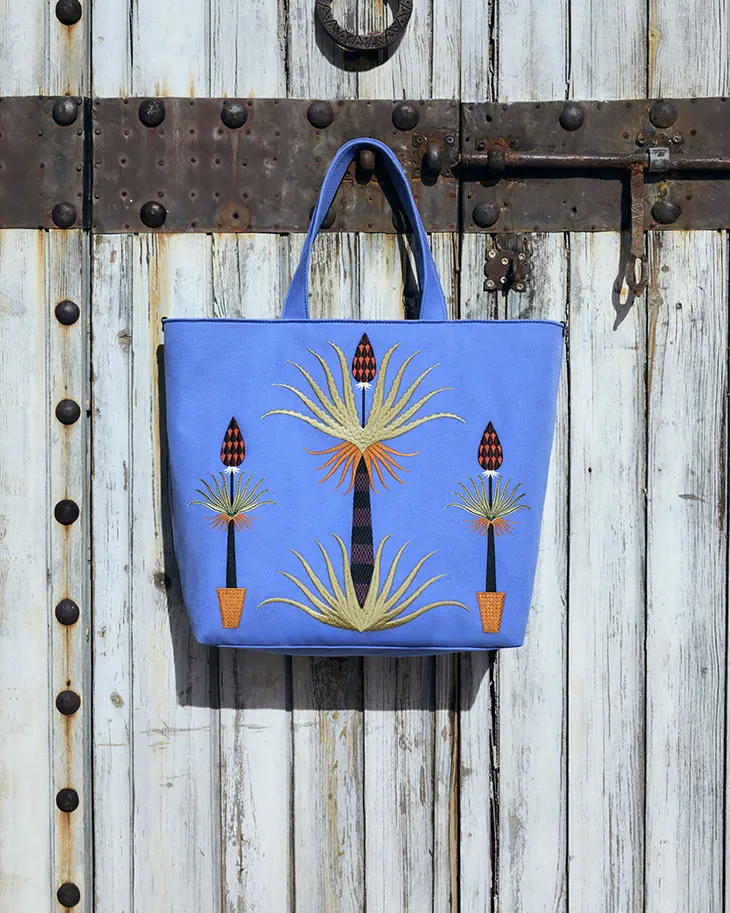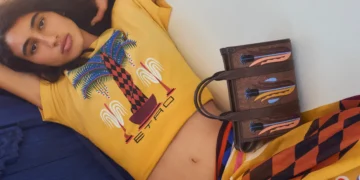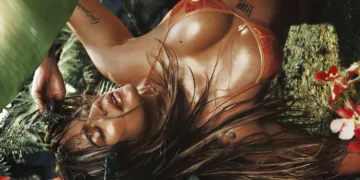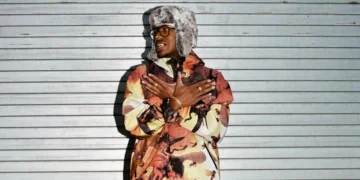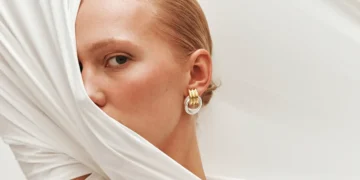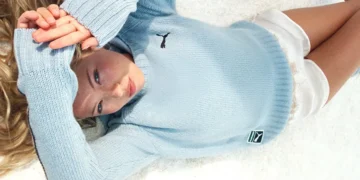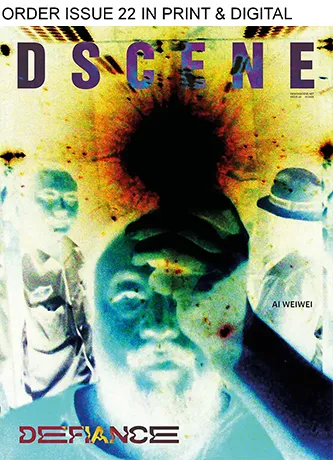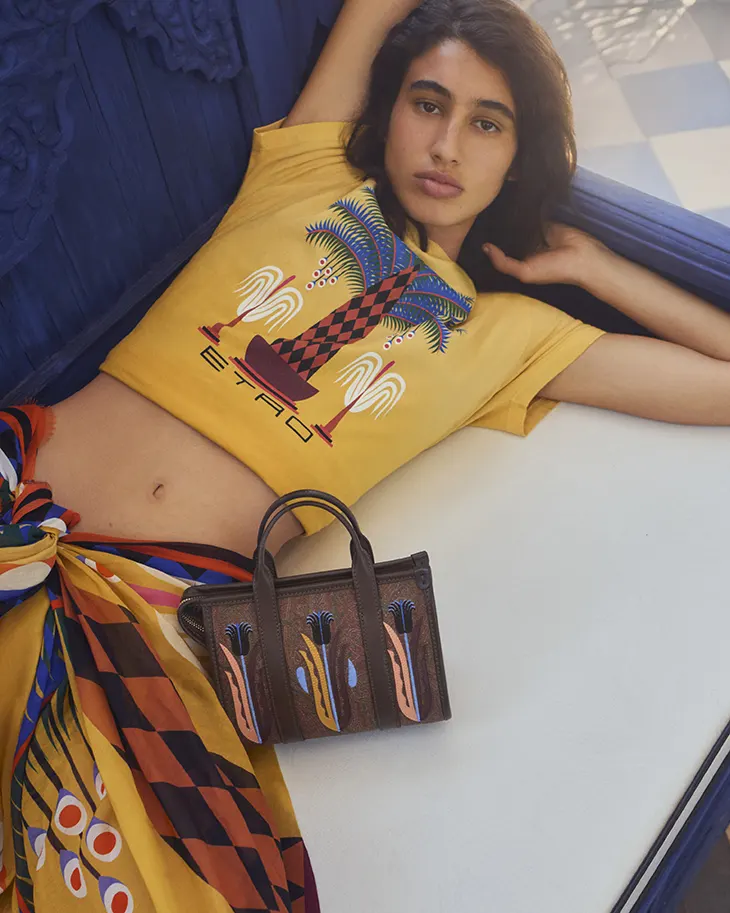
Etro’s Summer 2025 capsule emerges as a vivid Mediterranean vision shaped by Creative Director Marco De Vincenzo, featuring select pieces created in collaboration with artist Agostino Iacurci. This creative exchange brings together fashion’s material language and the visual rhythm of Iacurci’s botanical work across Arnica fabric bags, gauze scarves, cotton totes, and airy garments, pieces that channel the chromatic intensity and symbolic richness of visual art into everyday wear.
In this interview for DSCENE Magazine, Editor Katarina Doric connects with both De Vincenzo and Iacurci to explore how memory, texture, and mutual trust shaped this unique project. From references to Sicilian gardens and majolica tiles to the symbolic rebirth of the paisley motif, their dialogue reveals a shared sensitivity to place, tradition, and transformation, rendering summer not as a season, but a state of mind.
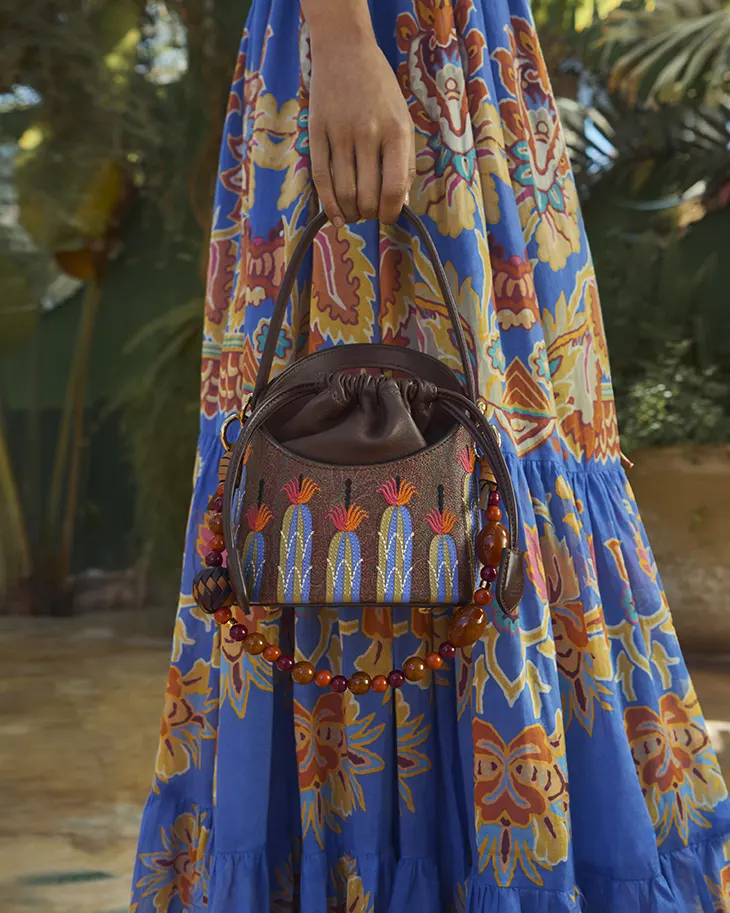
Marco De Vincenzo:
The Summer 2025 collection evokes a vivid Mediterranean reverie: sun-soaked, textured, and steeped in Etro’s signature eclecticism. Where did this season’s journey begin for you? – Although I try to find alternatives to the Mediterranean, my summer vacations are almost always dedicated to it. I am familiar with its landscapes and artistic influences; so, it often comes to mind when I’m designing any summer collection.
The prints reference everything from majolica tiles to hidden gardens. How do you curate these visual motifs in a way that feels both timeless and emotionally immediate? – I am Sicilian, and I believe I understand the meaning of the word “layering.” I only need to draw on my memories to recall an exotic rug laid over a floor of majolica tiles in a palm garden.
The collection features intricate textile techniques—fil coupé, jacquard, fringed trims—that speak to Etro’s artisanal legacy. How do you balance heritage craftsmanship with the desire to innovate? – Craftsmanship, heritage, and innovation have never been opposing concepts. If anything, they overlap and blend differently each time to best express the spirit of the times. And as we know, the future wouldn’t exist without the past.
The silhouettes move with ease and lightness, yet the construction feels deeply considered. What does effortless elegance mean to you in the context of modern dressing? – If there’s one thing that has drastically changed over the past ten years, it’s the gradual disappearance of the concept of uncomfortable fashion. Today, more than ever, any form of creativity that isn’t grounded in a real possibility of being lived—when it comes to fashion, worn—is almost unthinkable.
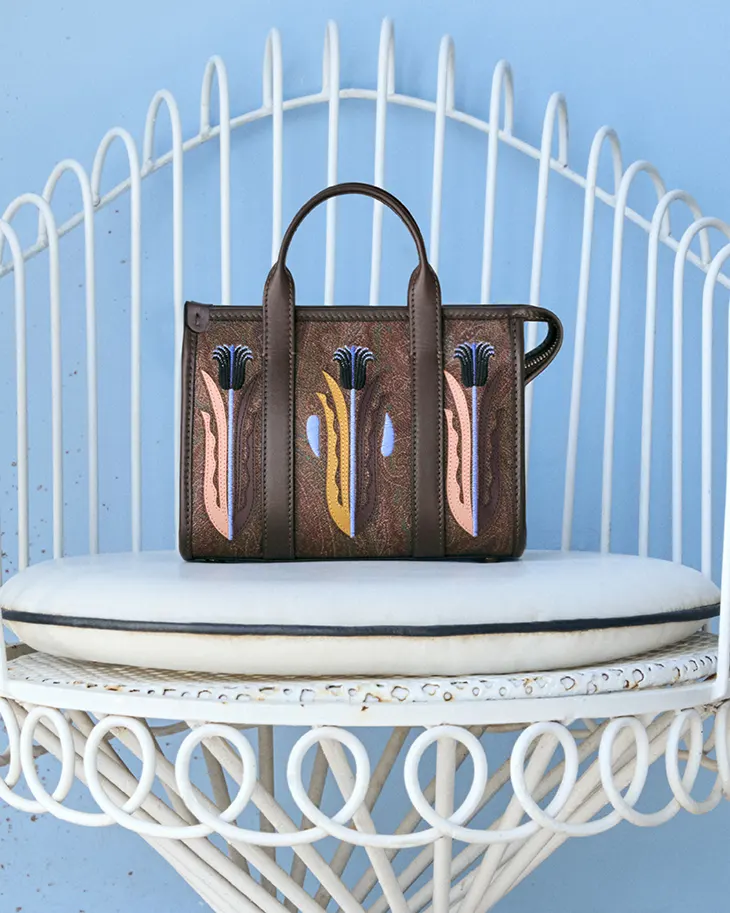
Collaborating with Agostino Iacurci brought a new visual vocabulary into the Etro universe. What drew you to his work, and how did you envision this creative dialogue unfolding? – I have been drawn to Augustino’s work for many years now. I find his synthesis of decoration perfect; I would describe him as a modern decorative artist—there are few who are as minimal and effective as he is.
What surprised or inspired you most during this collaboration? – I wouldn’t call it so much a surprise as a confirmation. Creativity invisibly connects people; all you need to do is recognize yourself in the world and join forces, and the result can only be rich and inspiring.
Etro has always existed at the intersection of fashion, culture, and art. How do collaborations like this one help expand the brand’s language without diluting its identity? – Etro is stronger than any new ingredient. The recipe will continue to evolve countless times, but the brand identity will emerge even stronger each time, because culture needs diversity to survive.
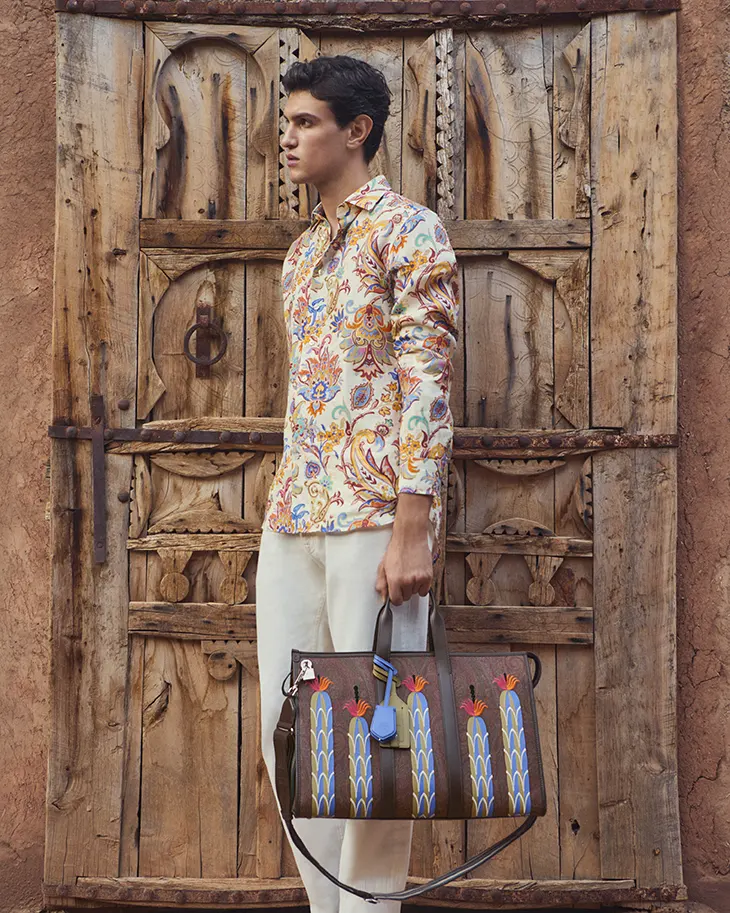
Agostino Iacurci:
Your work carries a strong sense of place and atmosphere—bold, poetic, and always deeply connected to nature. How did your artistic language evolve when transposed onto textiles? – In my work I’ve already experimented with textiles, but rarely in the context of objects meant to be used. Working with the Etro team allowed me to explore new possibilities—playing with layers of techniques, patches, stitching, and transparencies. In a way, the bags became small traveling sculptures.
In this collaboration, you reimagined Etro’s codes through your lens: botanical forms, vibrant color, expressive line. What conversations did you have with Marco and the team about bridging fashion and art? – Marco gave me great creative freedom. We’ve known each other for a long time, and I believe that meaningful collaborations always grow from mutual respect. For this specific project, the starting point was the Arnica fabric, which Etro is celebrating this year—characterized by the paisley motif, a botanical flourish with ancient roots. In Etro’s iconic version, it comes in earthy tones. For me, it became fertile ground from which to grow new plant forms—some drawn from real species that populate my artistic vocabulary, others imagined during the process, inspired by observing the paisley itself.
Textile behaves differently than walls or canvas. What discoveries did you make when working on pieces meant to be worn, moved in, and lived with? – When artworks become garments and objects, they are inevitably reinterpreted and transformed by the person who wears them. For example, the maxi pareo isn’t so different from a painting, but it has a transparency that shifts with the light, depending on how it’s folded, and it can be worn in countless ways—or simply laid out on sand in countless places. What fascinates me is how the wearer becomes a kind of co-author: their gestures, combinations, and movements bring new meanings to the piece. There’s also the emotional and tactile dimension: clothing and objects carry affection. I imagine a bag passed from parents to children, carrying with it memories, stains, emotions.
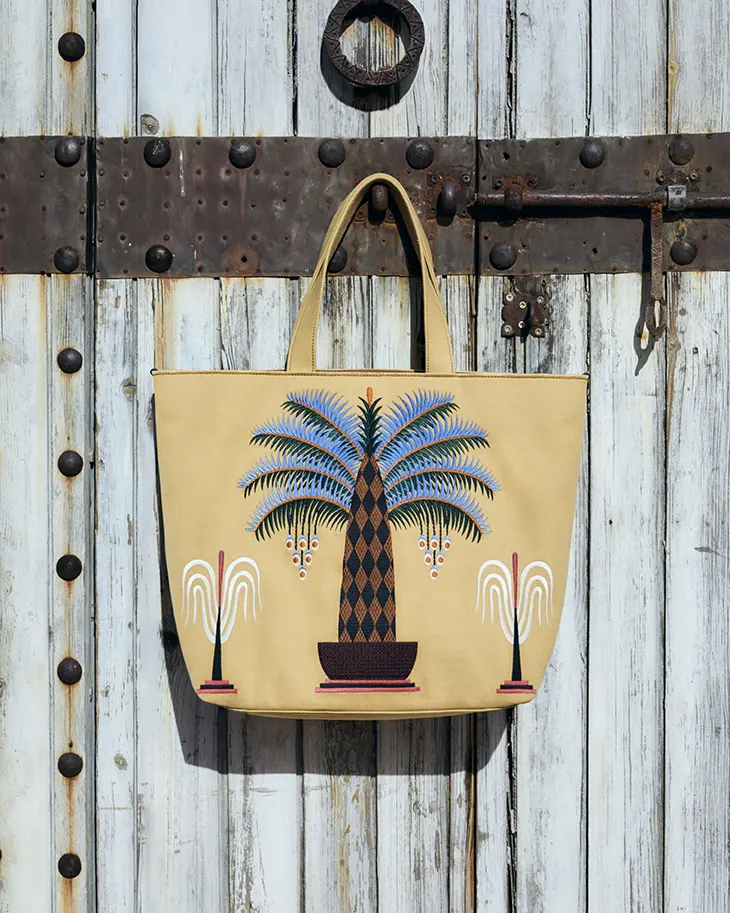
Your recurring use of botanical motifs feels especially resonant in this collection. What role do these organic forms play in your visual storytelling? – The botanical world is a constant source of inspiration—both for its pure aesthetic qualities and for the wealth of stories embedded in the landscapes around us. In this case, we started from Etro’s iconic paisley motif—an ancient decorative pattern, probably born as a wall or architectural ornament in Persia. It’s thought to represent a germinating date seed that grows into an intricate vegetal flourish. I imagined it as soil from which to grow a date palm—a recurring subject in my paintings—alongside aloe and cactus plants. All of these are deeply embedded in the landscapes of southern Italy, where both Marco and I are from, although they are native to other continents. These intersections fascinate and inspire me.
The collection walks a line between protection and expression—bags, scarves, clothing that carry your work into everyday life. What does it mean to you to see your art worn? – It’s always emotional. It fills me with gratitude. It means someone connected with your work enough to want to make it part of their life.
You’ve worked in public space around the world. How does the idea of fashion as a kind of moving mural, or portable artwork, align with your practice? – I think it’s a beautiful idea. My practice is moving toward something increasingly immersive—spaces, sounds, environments—so the idea of becoming part of people’s daily life is very meaningful to me.
Collaboration in fashion often asks for a shared rhythm. What did you enjoy most about working with Etro, and how do you feel the project reflects your artistic sensibility? – Marco explicitly asked me to stay true to my own poetic language. At the same time, Etro knows the materials so well and creates incredibly refined pieces, so it was beautiful to see how my artwork was adapted and engineered. When I finally held the finished objects in my hands, I realized just how much attention and care had gone into every single piece. It was like holding a materialized vision—woven with meaning, memory, and meticulous craftsmanship.
